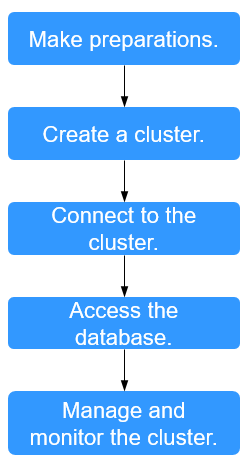Proceso para usar GaussDB(DWS)
GaussDB(DWS) es una base de datos de procesamiento de datos en línea que se ejecuta en la infraestructura de Huawei Cloud para proporcionar un servicio de base de datos analítico escalable, totalmente gestionado y listo para usar, liberándole de la gestión y supervisión complejas de bases de datos. Es un servicio en la nube nativo basado en el almacén de datos convergentes GaussDB de Huawei, y es totalmente compatible con el estándar de ANSI SQL 99 y SQL 2003, así como con los ecosistemas PostgreSQL y Oracle. GaussDB(DWS) proporciona soluciones competitivas para el análisis de big data a nivel de PB en varias industrias.
GaussDB(DWS) proporciona una consola de gestión fácil de usar, lo que le permite crear rápidamente clústeres y gestionar fácilmente almacenes de datos.
Descripción del proceso

|
Proceso |
Tarea |
Descripción |
Instrucción de operación |
|---|---|---|---|
|
Hacer preparaciones. |
- |
Antes de usar GaussDB(DWS), seleccione un puerto abierto en su firewall como puerto de base de datos del clúster de almacén de datos. |
|
|
Crear un clúster. |
- |
Cree un clúster antes de usar GaussDB(DWS) para ejecutar tareas de análisis de datos. Un clúster de GaussDB(DWS) contiene nodos en la misma subred. Estos nodos proporcionan conjuntamente servicios. Durante la creación del clúster, el sistema crea una base de datos predeterminada. |
|
|
Conectar al clúster. |
- |
Una vez creado correctamente el clúster del almacén de datos, utilice la herramienta de cliente SQL o un controlador de terceros como JDBC u ODBC para conectarse a la base de datos del clúster. Puede descargar la herramienta cliente SQL y el controlador JDBC/ODBC en la página Client Connections de la consola de gestión de GaussDB(DWS). |
|
|
Acceder a la base de datos. |
- |
Después de conectarse al clúster, puede crear y gestionar bases de datos, gestionar usuarios y permisos, importar y exportar datos y consultar y analizar datos. |
|
|
Gestionar y monitorear el clúster. |
Gestionar el clúster. |
Consulte el estado del clúster, modifique las configuraciones del clúster, agregue etiquetas de clúster y amplíe, reinicie y elimine el clúster. |
|
|
Gestionar la instantánea. |
Cree instantáneas para realizar copias de respaldo y restaurar el clúster. |
||
|
Realizar O&M y monitorización. |
Consulte el estado de ejecución y el rendimiento del clúster mediante el monitoreo, la auditoría de registros, la notificación de eventos y la gestión de la carga de recursos. |






